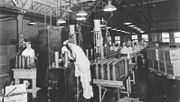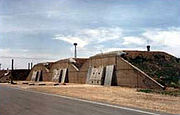
An aerial photograph of a portion of the Pantex Plant near Amarillo, Texas
The Pantex plant is America's only nuclear weapons assembly and disassembly facility and is charged with maintaining the safety, security and reliability of the nation’s nuclear weapons stockpile. The facility is located on a 16,000 acre (65 km2) site 17 miles (27 km) northeast of Amarillo, in Carson County, Texas in the Panhandle of Texas. The plant is managed and operated for the United States Department of Energy by BWXT Pantex and Sandia National Laboratories. BWXT Pantex is a limited liability enterprise of Babcock & Wilcox Technical Services Group, Honeywell and Bechtel.
History[]

Conventional weapons being assembled at Pantex in 1944

The Pantex plant was originally constructed as a conventional bomb plant for the United States Army during the early days of World War II. The Pantex Ordnance Plant was authorized February 24, 1942. Construction was completed on November 15, 1942 and caused workers from all over the U.S. to flock to Amarillo for jobs building bombs.
Pantex was abruptly deactivated after the war ended. It remained vacant until 1949, when Texas Technological College in Lubbock (now Texas Tech University) purchased the site for $1. Texas Tech used the land for experimental cattle-feeding operations.
In 1951, at the request of the Atomic Energy Commission (now the Department of Energy (DOE)), the Army exercised a recapture clause in the sale contract and reclaimed the main plant and 10,000 acres (40 km2) of surrounding land for use as a nuclear weapons production facility. The Atomic Energy Commission refurbished and expanded the plant at a cost of $25 million. The remaining 6,000 acres (24 km2) of the original site were leased from Texas Tech in 1989.

Technicians perform final assembly on a nuclear warhead
Also in 1989, the DOE Rocky Flats Plant, located near Golden, Colorado, was deactivated as a plutonium processing center due to environmental concerns, urban encroachment, and protest by activist groups and loss of mission when Congress did not approve the next generation weapon design. The deactivation of Rocky Flats necessitated the interim storage of plutonium at Pantex.
In 1994, the Pantex plant was listed as a Superfund site.[1] The US Environmental Protection Agency has not determined what contaminants and exposure risks are at the facility, but has determined that groundwater contamination was not under control at that time. Cleanup construction was completed in 2010, and EPA currently lists this site as "Current human exposures at this site are under control" and "Contaminated ground water migration is under control".[2] [3]
The Agency for Toxic Substances and Disease Registry in 1998 documented a statistically significant incidence of increased cancer rates and low birth weights in the some of the counties surrounding Pantex, however the counties closest to the plant (Armstrong and Carson) had no significant increase in cancer rates. The Agency for Toxic Substances and Disease Registry concluded that the Pantex Plant was not likely to be associated with these findings because of the multifactorial nature of birth defects and cancer, and the lack of measurable contamination coming from the Pantex facility.[4] Pantex employed approximately 3,600 people in 2010 and had a budget of $600 million for fiscal year 2010.[5]
Controversy[]
In the early 1980s, local Bishop Leroy Matthiesen tried persuading Catholic workers at the plant to leave their jobs, offering financial support to those who would do so. In 1986 activists, including Les and Cindy Breeding, purchased 20 acres (81,000 m2) adjacent to the facility to create "The Peace Farm," described as "a visible witness against weapons of mass destruction." The Peace Farm staff and board of directors organized peace camps, mother's day celebrations, and women's rights rallies, with such celebrities as Ed Asner, Odetta, Lou Reed, Wes Jackson, and Daniel Ellsberg at the Pantex Plant and Peace Farm through the 80s and 90s. The Peace Farm currently organizes educational and informational events related to the environment, nuclear proliferation and waste disposal, and peace issues. The activists also conducted prayer vigils and greeted workers leaving the plant, letting them know about a fund available to workers who chose to relocate or change jobs due to their objection to nuclear weapons proliferation and the health problems experienced by many workers at the Pantex plant. Convoys and trains originating at Pantex were tracked by activists who documented the routes and activity of nuclear weapons across the USA, in conjunction with the national Truck Watch Movement originated by journalist Sam Day of the Republic. The Peace Farm became a nonprofit organization and the board of directors currently conducts organizational and educational activities surrounding peace and a nuclear free environment in Amarillo and Panhandle, Texas.[citation needed]
A non-profit watchdog group, the Project on Government Oversight (POGO), claimed that in 2005 Pantex workers could have caused a nuclear explosion when they improperly applied too much pressure on an obsolete W56 warhead while attempting to dismantle it.[6] POGO said unidentified experts knowledgeable about the event told it of the danger. It also said requirements for plant technicians to work up to 72 hours a week contributed to the incident. The group made public an anonymous letter, purportedly from Pantex workers, which warned that long hours and efforts to increase output were causing dangerous conditions. BWXT said it would look into the complaint about unsafe conditions, but declined further comment. The U.S. Department of Energy fined BWXT $110,000 for incidents involving the bomb, but did not mention any possibility of an explosion or identify the type of warhead.[6]
Labor troubles[]
Labor troubles arose in 2007 following the implementation of stricter physical and combat performance requirements for armed nuclear security personnel following the September 11th attacks. The worker's union for the Pantex guards protested that the new standards—including requiring all guards to wear bulletproof vests and carry rifles during their 12-hour guard shift—were unfairly strenuous to middle-aged personnel nearing retirement.[7]
500 guards walked off the site and went on strike just after midnight on April 20, 2007 and were replaced with a temporary guard force.[8] After 45 days of intense negotiations, a new 5 year contract was agreed upon between the Pantex Guards Union and BWXT.
Security incidents[]
The plant was put on lockdown about 8 AM (Central Time) on January 15, 2010 due to a potential security situation. The lockdown was caused when a Pantex lab worker reported seeing two men wearing camouflage and carrying rifles exit a vehicle a "couple of miles" from the plant. After a lockdown and a full security response, the men were found to be Pantex employees on their day off goose hunting on private property. No charges were filed.[9]
Footnotes[]
- ↑ NPL Sites in Texas | National Priorities List (NPL) | US EPA[dead link]
- ↑ "US Superfund Information". US Superfund Information. Environmental Protection Agency. http://cfpub.epa.gov/supercpad/cursites/csitinfo.cfm?id=0604060. Retrieved 26 November 2011.
- ↑ EPA report on Pantex
- ↑ ATSDR - PHA - Pantex Plant, Amarillo, Carson County, Texas
- ↑ "Pantex Info". Pantex Info. U.S. Department of Energy/National Nuclear Security Administration. http://www.pantex.com/ucm/groups/exweb/@exweb/@pr/documents/web_content/ex_doc_gen_ovrview.pdf. Retrieved 26 November 2011.
- ↑ 6.0 6.1 Nesmith, Jeff (December 15, 2006). "Watchdog: Firm nearly detonated nuke bomb". Arizona Daily Star. http://azstarnet.com/news/article_f069a585-4e0a-51b6-830d-b7712c7d776d.html. Retrieved October 5, 2011.
- ↑ Fit to Guard Weapons?. US News and World Report. April 30, 2007.
- ↑ LP: Security Guards Go On Strike At U.S. Nuclear Weapons Plant
- ↑ Texas Nuclear Weapons Plant On Lockdown
See also[]
| Wikimedia Commons has media related to Pantex Plant. |
- National Nuclear Security Administration
- CEA/Valduc
- Kansas City Plant
External links[]
- "Home page". http://www.pantex.com/.
- "Pantex Plant Operations". BWX Technologies, Inc.. http://www.bwxt.com/operations/pantex.html. Retrieved March 14, 2006.
- "Dismantling the Bomb, Or What I Did On My Summer Vacation". http://web.archive.org/web/20031230202652/http://www.mmmfiles.com/archive/pantex.htm. Retrieved March 24, 2013.
- Annotated bibliography for Pantex from the Alsos Digital Library for Nuclear Issues
- Pantex links at Nuclearpathways.org
- website eksternal
- website intern
{{URL|example.com|optional display text}}
Coordinates: 35°18′42″N 101°33′35″W / 35.311568°N 101.559725°W
The original article can be found at Pantex Plant and the edit history here.